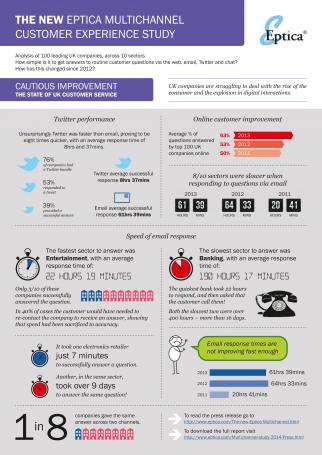What’s the state of the UK customer experience? 8 Key Findings

In an increasingly competitive economy, delivering the best customer experience is crucial for organisations looking to win new business and retain existing customers. However it has never been more difficult. Customers are demanding more, across an increasing range of channels and are swift to punish those that don’t deliver – either via social media or by moving their business elsewhere.
Launched this week, the latest version of the Eptica Multichannel Customer Experience Study has found that UK companies are struggling to deal with this shift in power towards consumers, and the explosion in digital interactions through channels such as social media, the web and email. The Study uncovered huge discrepancies in performance across sectors and channels - and between the best and worst companies.
Carried out from the point of view of the consumer, the Eptica Multichannel Customer Experience Study evaluated 100 leading UK companies on their ability to provide answers to 10 routine questions via the web, as well as their speed and accuracy when responding to email, Twitter and web chat. It repeated research carried out over the past two years to show market trends across the insurance, travel, entertainment retail, food retail, electronics retail, consumer electronics manufacturers, utilities, fashion retail, telecoms and banking sectors.
Due to its scale and scope the Study contains an enormous amount of information, and so we’ll be running a series of blog posts over the coming months, focusing on its findings for specific vertical markets and channels.
Firstly, what are the top 8 key findings of the research?
1. Cautious improvement on the web
Companies are now successfully answering more questions on their websites than a year ago, with the average of 63% up 10% on previous figures. This is being driven by growth in the use of web self-service software, with over half (53%) of companies having now deployed these systems on their websites.
2. Gaps between best and worst growing
Nearly a third of companies (32%) failed to answer more than half of the 10 basic questions they were asked online, yet 22% scored eight or more. There are major differences in performance, even in the same sector. For example, one entertainment retailer scored 100%, yet two competitors just 20%.
3. The email channel is broken
Email performance continues to decline. Just 71% of companies provided email contact details on their websites and only 41% answered emails accurately, meaning nearly six in ten questions were going unanswered. Overall, eight out of ten sectors answered email slower on average than a year ago.
4. Twitter performance is patchy
Social media has been a major growth channel, but performance is patchy. While responses on Twitter are faster than email, customers are less likely to receive an accurate reply, with just 39% of companies answering successfully.
5. Web chat delivers speed and accuracy
Web chat was surveyed for the first time and provided the greatest accuracy (93.5%) and fastest response, with an average conversation time of just 4 minutes and 29 seconds. However, just 7% of companies offered reactive chat, despite industry studies showing that it increases efficiency, helps sales and is well-accepted by consumers.
6. Consistency is lacking
Just 12% of companies gave a consistent response across all the digital channels they offered, such as email, Twitter and chat. Some directly contradicted themselves in their answers from channel to channel!
7. Companies are picking channels to focus on
Many companies that were strong on one channel were weak on others – for example electronics manufacturers answered an average of 70% of questions asked on the web, but just 30% of emails or tweets. In contrast telecoms companies responded successfully to 60% of tweets, but just 10% of emails.
8. Channels are being switched off
There is also a shrinking choice of channels available to non-customers looking to contact organisations. Just over half of companies (55%) offered two channels (normally email and Twitter) alongside their websites, but 5% provided no way of contacting them through digital channels, forcing potential customers to pick up the phone to find out information.
To read more about the results of the new Eptica Multichannel Customer Experience Study take a look at our infographic or download the full management report, which includes sector by sector breakdowns and a best practice guide to improving the customer experience.








Comments